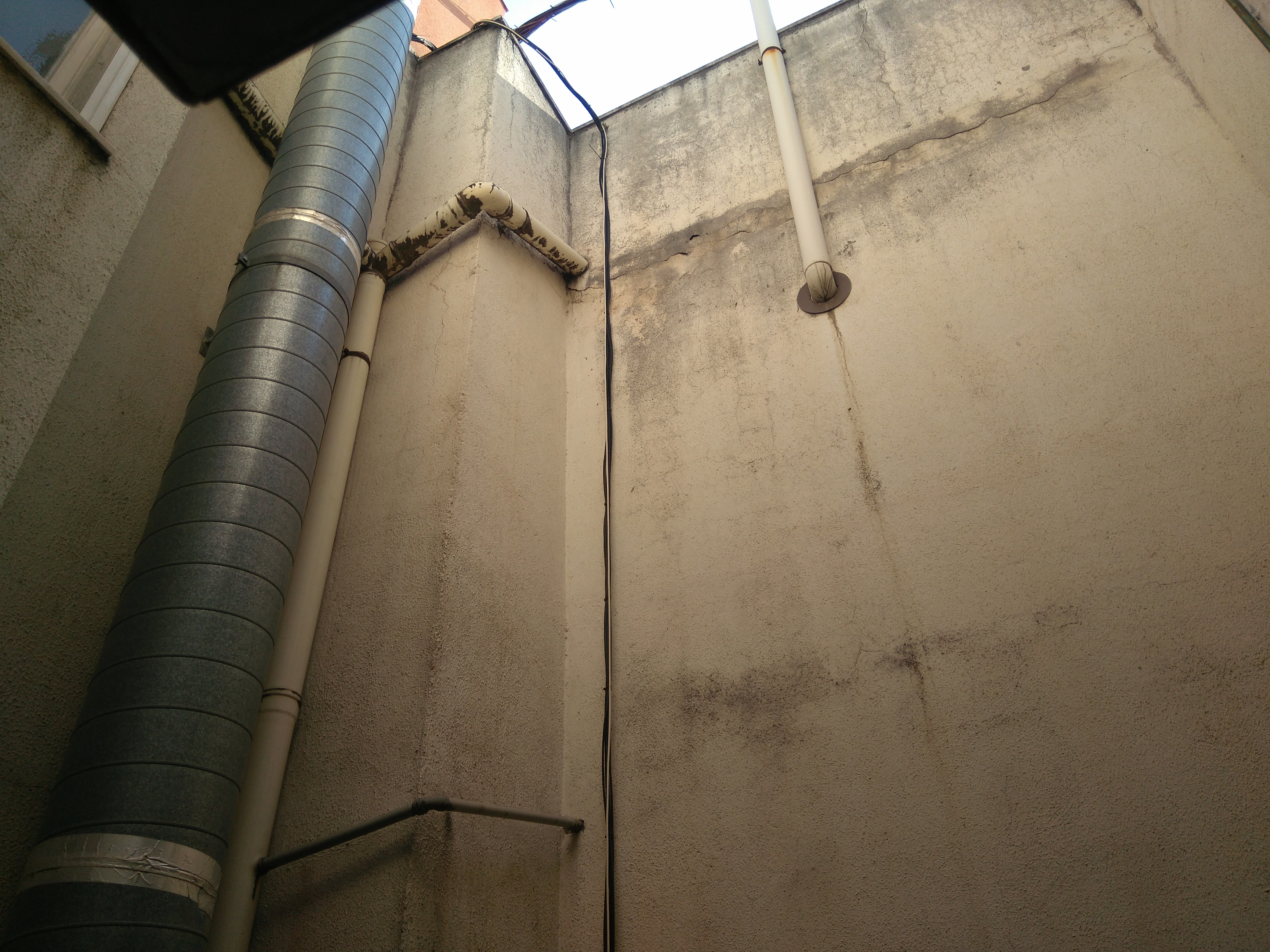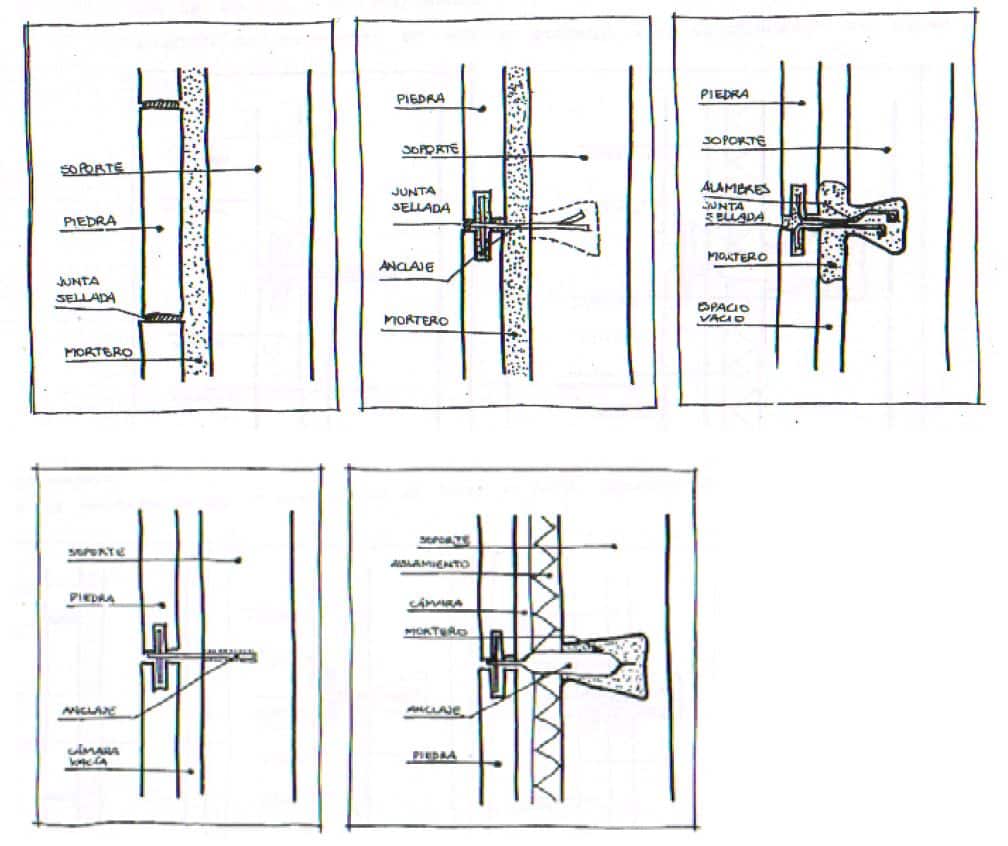The most common rehabilitation action carried out by the communities is that of the arrangement of the façade. The facades are highly exposed to inclement weather and due to their height are likely to cause risky situations. For example, a bad condition of a piece in the upper parts can endanger people who walk on the street.
Before spending a lot of money to rehabilitate the facade, it is convenient to find out what the problem is, where the defect comes from.
This requires an inspection by a qualified technician. These inspections can be part of the ITE or they can be commissioned independently. Ask us for a quote and advice on how to approach the repair of your facade through this form:
Error: Contact form not found.
Main defects of the facades
Facade cracks
Description of the problem
The main problem that a cracking of the facade generates is leaks of water and air inlet. We refer to the entry of moisture from outside, mainly from rains and in exceptional cases from planters, swimming pools, etc.
Causers and detection
Cracking due to aging
In a continuous coating material such as cement or lime mortar, the passage of time (in the face of sun exposure, changes in temperature between night and day, rain, etc.) causes the material to lose elasticity progressively and finally, before a change in temperature, it cracks. Normally these cracks are characteristic because they do not have a clear directionality and appear in the form of a “map” or a frame.

Gaskets of the system
Sometimes water can also enter through the joints of the façade material, in the case of brick facades or cladding. In the following image it can be seen that the joints of the brickwork are not clogged, and together with an aging of the brick itself, they can be the cause of leaks:

Cracking due to structural actions
Another cause is cracking due to structural causes. It is possible that the facade element has entered into load and was not ready for it. The case in the image below is a differential settlement fissure of the ground, the fissure occurs from the outside of the lintel upwards in a parabolic shape.

The following photo shows a horizontal fissure in the façade, which appears due to the expansion pressure exerted by the roof on the façade. This occurs because no elastic band has been placed around the perimeter that can absorb the expansions of the surface board of the roof.

Structural joint cracking
We have also observed on occasion that the deterioration of the structural joint of the building (in relatively long buildings, of more than 40 m approx. Where there are expansion joints of the structure) can cause the entry of water. The materials with which these joints are sealed are initially very elastic, but over the years they become more rigid until they crack and even lose material. As seen in the image below:

In some exceptional cases we find humidity that is caused by a porosity of the material (when the materials age they become much more porous or if it is a very fine facade in which the water has little to penetrate to reach the interior). It occurs in cases of deteriorated mortar, manual bricks.
Possible repairs
In the case of cracks due to aging of the material, the only repair possible It is the replacement of the finish, either in the most deteriorated areas or in its entirety.
If the cracks occur in specific areas, it is possible to act specifically in that place. In the case of cracks due to structural causes, it is always necessary to act on the cause of the problem: for example, if it is a differential settlement, the foundation will have to be repaired, since if the crack is repaired with a staple, the crack will probably reappear.
Stains
Description of the problem
Stains can appear for various reasons but are generally due to the action of rain. The staining dirt may come from the same material or are surface dirt stains.
Causers and detection
The causes of stains on the facades of our buildings can be very diverse:
Material defect
In a brick wall, when the bricks are not properly fired, it is possible in the manufacturing process that the soluble salts of the material have not been eliminated. The moment rainwater penetrates the material and then evaporates to the outside, it can carry away the salts from the inside.

Constructive solution defect
The most common example we come across is that the façade has a Rainfall designed or executed in a poor way and the waters that fall on it wash away the dirt, generating drips of dirt on the façade.


Possible repairs
Carry out suitable constructive solutions, pieces of gutter with flight and suitable drip.
To design elements to protect the facades in the building, the crowning cornices with generous eaves, the balconies and other elements that shade and prevent the wind and rain from hitting the façade and deteriorating its finish are useful.
Use quality materials, suitable and compatible with each other, for example, if we decide to use a breathable mortar we have to paint the facade also with a breathable paint if we do not want to find widespread flaking in a short time.
Landslides
Problematic description
The detachment can occur in facades of both adhered piece finishes and continuous coatings (we ignore in this section detachments of pieces in ventilated facades or curtain walls)
It is produced by a loss of adhesion of the piece or finishing material of the support, it is initially manifested with a bulging of a part of the facing before the material falls. It is especially serious since a fall of material from the facade can cause serious damage to third parties.
Causers and detection
Bonded parts
Detachment of adhered parts that lose adhesion due to the passage of years or a defective material. We have observed that some pieces of old facades were fixed only with “globs” and the whole piece was not completely hooked.
It may also happen that the appropriate type of adhesive is not used in the case of, for example, a porcelain tile fixed with cement mortar, which should be fixed with a glue cement. These cements contain a high percentage of resins and this makes them have a much more adequate flexibility and a higher adherence to low porosity materials such as porcelain tile.
The following image shows the detachment of parts from the support, due to a deterioration of the grip material:

Deterioration of reinforced concrete
In the image below we see the detachment due to deterioration of the reinforced concrete: concrete breakage due to the oxidation of the reinforcements.

Continuous coatings
In the following photos we see detachment of the continuous mortar coatings, which lose elasticity and adherence over the years:
Possible repairs
In the case of detachments in facades of ceramic pieces, it is necessary to carry out a general cleaning of the puffy or bulging areas. It is appropriate to follow a system similar in physical characteristics to the pre-existing one (vapor permeability, elasticity, adherence, etc.) and to use textile or fiberglass reinforcement to reinforce and avoid cracks.

In the case of natural or artificial stone facades, with an architectural value that is worth preserving, mechanical systems can be used to hold the pieces. They can be seen, semi-hidden or hidden.

Capillarity moisture
Description of the problem
The moisture by capillarity appears because in most of the Building materials form capillary networks due to their minimally porous nature. Brick, sand and cement mortar, most stones, all of these are materials that are susceptible to humidity rises due to capillarity.
The walls act like a sugar cube when we put it in contact with the coffee, it “absorbs” the liquid causing a rise in humidity.
Causers and detection
When there is water on the floor of the building (either due to seasonal humidity, sporadic seepage or because the water table is close to the foundation) the walls will “absorb” this humidity and this will cause chipping, blowing of the cladding and other construction defects. .

These defects are usually located where there is moisture in the soil: on the interior walls of the building located in the basement or in basements, in the lower parts of the facades of the buildings, etc.
Possible repairs
In a previous post we spoke exhaustively about the techniques of repair of capillary damp .
Broadly speaking, these repairs consist of canceling the network of capillaries in the material that cause the rise of water inside the material. There are three main ways to do it:
- Counteracting the surface tension of the capillaries through electroosmosis.
- With a physical barrier (waterproof sheet, lead sheet, etc …) that cuts the capillary network.
- Through ventilation (attached ventilated chambers, etc.)
Oxidation of attached elements
Description of the problem
There are normally a large number of metal elements on the facades that are attached or embedded in them. For example, guardrails, sills for placing pots on the windowsill, awning structures, protective eaves
Causers and detection
The cause of the cracking and bulging of the elements where the metal profile is embedded is its oxidation. Since steel increases up to 10 times its size when it rusts, this exerts a pressure that causes the material to break.
Possible repairs
The best thing to do is to start the element and partially replace it. Executing a joint with the appropriate support element, a plate anchor with epoxy plugs to which the railing is welded would be much more suitable since the joint could be protected with an elastic element that would prevent its oxidation.
















